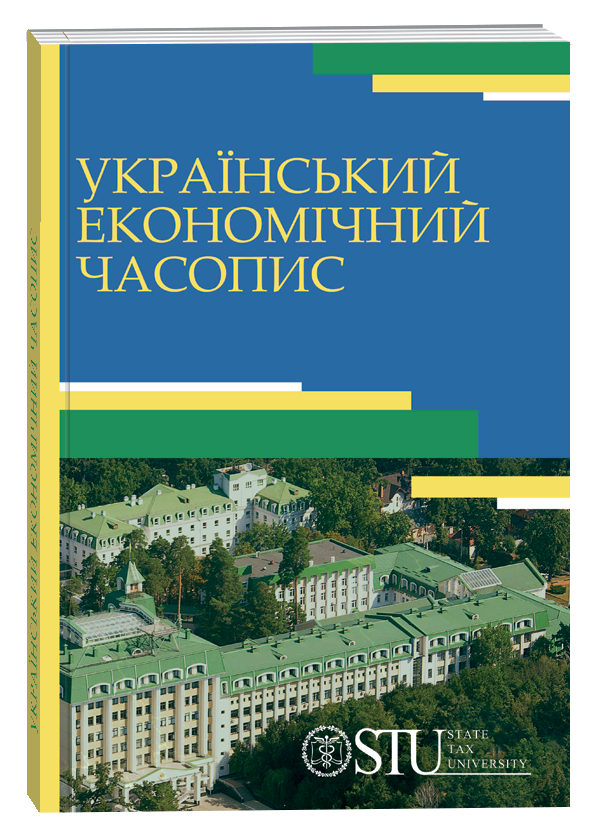THE ROLE OF ARTIFICIAL INTELLIGENCE IN THE FORMATION AND DEVELOPMENT OF URBAN CLUSTERS IN THE GLOBAL ECONOMIC ENVIRONMENT: PROSPECTS FOR DEVELOPING COUNTRIES
DOI:
https://doi.org/10.32782/2786-8273/2024-7-22Keywords:
artificial intelligence, urban clusters, predictive models, sustainable development, data analysis, global environmentAbstract
The article examines the role of artificial intelligence (AI) in the formation and development of urban clusters within the global economic environment. This issue is significant given the need for effective management of urban processes, especially in developing countries, where rapid urban growth demands innovative approaches to planning and resource allocation. Purpose. The aim of the study is to identify the significance and potential of AI in the formation of urban clusters, with a focus on developing countries. The research seeks to explore ways of using AI to optimize urban management processes and promote sustainable development. Methods. The study employed general scientific methods, such as analysis, synthesis, modeling, and a systems approach. These methods support a comprehensive examination of the processes involved in urban cluster formation, taking into account multifactorial influences. Results. The findings indicate that urban cluster formation follows certain patterns that can be accurately assessed and monitored using AI. AI proves to be a valuable tool for detailed analysis and data collection, allowing consideration of multiple variables, including demographic trends, economic potential, infrastructure characteristics, and environmental conditions. Additionally, AI facilitates the development of predictive models for optimal planning and resource allocation. Conclusions. The study concludes that AI utilization in urban cluster formation enhances infrastructure efficiency, addresses environmental challenges, and optimizes the use of natural and financial resources. In developing countries in particular, AI supports effective resource planning and allocation, reducing costs and fostering sustainable urban development models that align with current needs and promote innovation and economic growth.
References
AI is driving urban evolution. Wilo. 2023. URL: https://wilo.com/en/Pioneering/Stories/AI-is-driving-urban-evolution_42176.html
Ascher C.S., Geddes P. The Outlook Tower Association. Cities in Evolution. Land Econ. 1951. No. 27. URL: https://www.jstor.org/stable/3159745?origin=crossref
Chukhnii O., Zvarych R., Lutsiv R. AI as a driver of formation of intelligence city geoeconomic clusters in China. Інноваційні процеси економічного та соціально-культурного розвитку: вітчизняний та зарубіжний досвід : матеріали дoпoвiдeй XVІ Міжнародної науково-практичної конференції молодих учених і студентів, Tepнопіль, 28-29 березня 2023 р. Tepнопіль : ЗУНУ. 2023. С. 161–163. URL: http://dspace.wunu.edu.ua/bitstream/316497/49043/1/Chukhnii%20Oleh.pdf
Getis A., Ord J.K. The Analysis of Spatial Association by Use of Distance Statistics. Perspect. Spat. Data Anal. 1992. No. 24. P. 127–145. DOI: https://doi.org/10.1111/j.1538-4632.1992.tb00261.x
He X., Cao Y., Zhou C. Evaluation of Polycentric Spatial Structure in the Urban Agglomeration of the Pearl River Delta (Prd) Based on Multi-Source Big Data Fusion. Remote Sens. 2021. No. 13. URL: https://www.mdpi.com/2072-4292/13/18/3639
Huang W., Zhang D., Mai G., Guo X., Cui L. ISPRS Journal of Photogrammetry and Remote Sensing Learning Urban Region Representations with POIs and Hierarchical Graph Infomax. ISPRS J. Photogramm. Remote Sens. 2023. 196. C. 134–145. URL: https://linkinghub.elsevier.com/retrieve/pii/S0924271622003148
Li L., Ma S., Zheng Y., Xiao X. Integrated Regional Development: Comparison of Urban Agglomeration Policies in China. Land Use Policy 2022. No. 114. URL: https://www.sciencedirect.com/science/article/abs/pii/S0264837721006621?via%3Dihub
List of largest urban areas by continent. Wikipedia. 2024. URL: https://en.wikipedia.org/wiki/List_of_largest_urban_areas_by_continent
Peng J., Hu Y., Liu Y., Ma J., Zhao S. A New Approach for Urban-Rural Fringe Identification: Integrating Impervious Surface Area and Spatial Continuous Wavelet Transform. Landsc. Urban Plan. 2018. No. 175. P. 72–79. URL: https://linkinghub.elsevier.com/retrieve/pii/S016920461830077X
Stehman S.V. Selecting and Interpreting Measures of Thematic Classification Accuracy. Remote Sens. Environ. 1997. No. 62. P. 77–89. URL: https://linkinghub.elsevier.com/retrieve/pii/S0034425797000837
Tannier C., Thomas I. Defining and Characterizing Urban Boundaries: A Fractal Analysis of Theoretical Cities and Belgian Cities. Comput. Environ. Urban Syst. 2013. No. 41. P. 234–248. URL: https://www.sciencedirect.com/science/article/abs/pii/S0198971513000641?via%3Dihub
Yu Q., Li M., Li Q., Wang Y., Chen W. Economic Agglomeration and Emissions Reduction: Does High Agglomeration in China’s Urban Clusters Lead to Higher Carbon Intensity? Urban Clim. 2022. No. 43. URL: https://linkinghub.elsevier.com/retrieve/pii/S221209552200092X
Zhang D., Liu J. Study on the Model of Regional Differentiation of Land Use Degree in China. J. Nat. Resour. 1997. No. 12. P. 105–111.
Кузьмін О, Станасюк Н., Оліховська М. Застосування кластерного підходу до розвитку промислового потенціалу: підтримка інноваційної політики та управління. Економіка, підприємництво, менеджмент. 2017. No. 4(1). URL: https://eem.com.ua/uk/journals/tom-4-1-2017/zastosuvannya-klasternogo-pidkhodu-do-rozvitku-promislovogo-potentsialu-pidtrimka-innovatsiynoyi-politiki-ta-upravlinnya
Становлення українських кластерів. Ucluster. 2024. URL: https://ucluster.org/universitet/klastery-ukraina/
Чухній О.Ю., Зрибнєва І.П., Оленюк Д.О. Глобалізація економіки країни в умовах розвитку штучного інтелекту: роль інноваційних продуктів. Академічні візії. 2023. No. 22. DOI: http://dx.doi.org/10.5281/zenodo.8251930
Wilo. (2023) AI is driving urban evolution. Available at: https://wilo.com/en/Pioneering/Stories/AI-is-driving-urban-evolution_42176.html
Ascher C. S., & Geddes P. (1951) The Outlook Tower Association. Cities in Evolution. Land Economics, no. 27. Available at: https://www.jstor.org/stable/3159745?origin=crossref
Chukhnii O., Zvarych R., & Lutsiv R. (March 28-29, 2023) AI as a driver of formation of intelligence city geoeconomic clusters in China. Innovatsiini protsesy ekonomichnoho ta sotsialno-kulturnoho rozvytku: vitchyznianyi ta zarubizhnyi dosvid : materialy dopovidei XVI Mizhnarodnoi naukovo-praktychnoi konferentsii molodykh uchenykh i studentiv. Ternopil: ZUNU, pp. 161–163. Available at: http://dspace.wunu.edu.ua/bitstream/316497/49043/1/Chukhnii%20Oleh.pdf
Getis A., & Ord J. K. (1992) The Analysis of Spatial Association by Use of Distance Statistics. Perspectives on Spatial Data Analysis, no. 24, pp. 127–145. DOI: https://doi.org/10.1111/j.1538-4632.1992.tb00261.x
He X., Cao Y., & Zhou C. (2021) Evaluation of Polycentric Spatial Structure in the Urban Agglomeration of the Pearl River Delta (PRD) Based on Multi-Source Big Data Fusion. Remote Sensing, no. 13. Available at: https://www.mdpi.com/2072-4292/13/18/3639
Huang W., Zhang D., Mai G., Guo X., & Cui L. (2023) Learning Urban Region Representations with POIs and Hierarchical Graph Infomax. ISPRS Journal of Photogrammetry and Remote Sensing, no. 196, pp. 134–145. Available at: https://linkinghub.elsevier.com/retrieve/pii/S0924271622003148
Li L., Ma S., Zheng, Y., & Xiao, X. (2022) Integrated Regional Development: Comparison of Urban Agglomeration Policies in China. Land Use Policy, no. 114. Available at: https://www.sciencedirect.com/science/article/abs/pii/S0264837721006621?via%3Dihub
Wikipedia (2024) List of largest urban areas by continent. Available at: https://en.wikipedia.org/wiki/List_of_largest_urban_areas_by_continent
Peng J., Hu Y., Liu Y., Ma J., & Zhao S. (2018) A New Approach for Urban-Rural Fringe Identification: Integrating Impervious Surface Area and Spatial Continuous Wavelet Transform. Landscape and Urban Planning, no. 175, pp. 72–79. Available at: https://linkinghub.elsevier.com/retrieve/pii/S016920461830077X
Stehman S. V. (1997) Selecting and Interpreting Measures of Thematic Classification Accuracy. Remote Sensing of Environment, no. 62, pp. 77–89. Available at: https://linkinghub.elsevier.com/retrieve/pii/S0034425797000837
Tannier C., & Thomas I. (2013) Defining and Characterizing Urban Boundaries: A Fractal Analysis of Theoretical Cities and Belgian Cities. Computers, Environment and Urban Systems, no. 41, pp. 234–248. Available at: https://www.sciencedirect.com/science/article/abs/pii/S0198971513000641?via%3Dihub
Yu Q., Li M., Li Q., Wang Y., & Chen W. (2022) Economic Agglomeration and Emissions Reduction: Does High Agglomeration in China’s Urban Clusters Lead to Higher Carbon Intensity? Urban Climate, no. 43. Available at: https://linkinghub.elsevier.com/retrieve/pii/S221209552200092X
Zhang D., & Liu J. (1997) Study on the Model of Regional Differentiation of Land Use Degree in China. Journal of Natural Resources, no. 12, pp. 105–111
Kuzmin O., Stanasiuk N., & Olikhovska M. (2017) Zastosuvannia klasternoho pidkhodu do rozvytku promyslovoho potentsialu: pidtrymka innovatsiinoi polityky ta upravlinnia [Application of a cluster approach to industrial potential development: support for innovation policy and management]. Ekonomika, pidpryiemnytstvo, menedzhment, no. 4(1). Available at: https://eem.com.ua/uk/journals/tom-4-1-2017/zastosuvannya-klasternogo-pidkhodu-do-rozvitku-promislovogo-potentsialu-pidtrimka-innovatsiynoyi-politiki-ta-upravlinnya (in Ukrainian)
Ucluster (2024) Stanovlennia ukrainskykh klasteriv [Formation of Ukrainian clusters]. Available at: https://ucluster.org/universitet/klastery-ukraina/ (in Ukrainian)
Chukhnii O. Yu., Zrybnieva I. P., & Oleniuk D. O. (2023) Hlobalizatsiia ekonomiky krainy v umovakh rozvytku shtuchnoho intelektu: rol innovatsiinykh produktiv [Globalization of the country's economy in the conditions of artificial intelligence development: role of innovative products]. Akademichni viziji, no. 22. DOI: http://dx.doi.org/10.5281/zenodo.8251930 (in Ukrainian)



